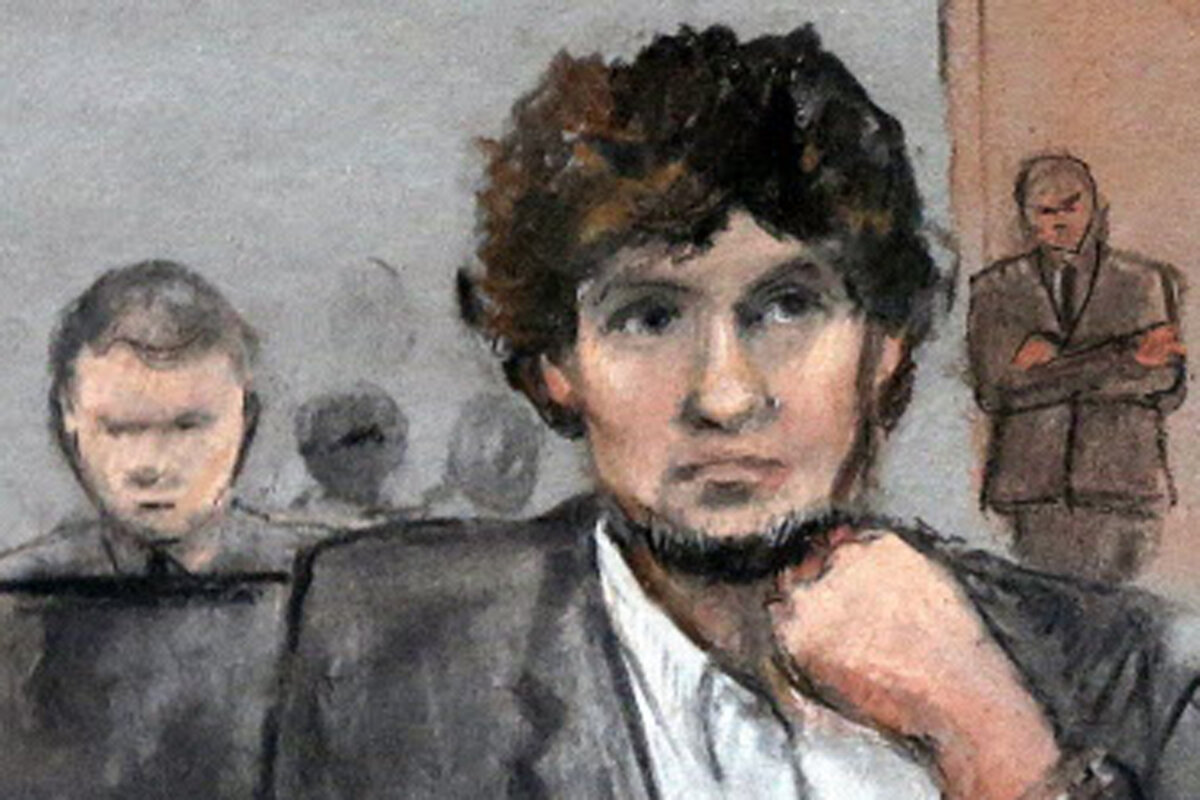Has Boston bombing trial changed perceptions of Dzhokhar Tsarnaev?
Loading...
| Boston
Henry Nields stood in federal court earlier this week with rubber gloves on, holding up a small pair of tattered shorts. Or they might be underpants, he said.
“It’s difficult to say because of the melted fabric,” the Massachusetts chief medical examiner testified to a silent courtroom.
The clothing belonged to 8 year-old Martin Richard, the youngest victim of the 2013 Boston Marathon bombings and the focus of the government’s emotional conclusion to their case against the accused bomber Dzhokhar Tsarnaev.
As several jurors began to cry, and as Martin’s parents held each other in the gallery, Mr. Tsarnaev sat motionless at a table, flanked by his lawyers. If he felt any reaction to Dr. Nield’s testimony, he didn’t show it visibly.
In the rectangular courtroom in the federal courthouse in South Boston, the accused Boston Marathon bomber sits every day, silently, near the geometric center of the room and at the center of the trial itself.
His chair – between lead defense lawyers Judy Clarke and Miriam Conrad – is almost equidistant between the witness box to his right, the 18-person jury box to his left, Judge George O’Toole in front of him, and a gallery of journalists, family members, and members of the public behind him.
When he enters the courtroom every morning a flurry of tweets describe his clothing – about the only thing different about him from day to day. His smallest movements and physical reactions are chronicled, though he has done little more than lean back in his chair or scratch his nose during a month of sometimes graphic testimony.
Tsarnaev’s defense team rested its case Tuesday after calling only four witnesses. The jury are all but certain to find him guilty once they begin deliberations next Monday – sending the trial to a second phase to determine whether he should receive the death penalty or life in prison. The trial will then shift from how Tsarnaev participated in the bombings to why he participated. Focus on his physical and emotional reactions is only going to intensify.
Rosanna Cavallaro, a law professor at Suffolk University and former state assistant attorney general, says that the public – especially the jury – are probably eager to hear more about Tsarnaev himself.
“They’re trying to literally read the tea leaves of his affect, whether he does or doesn’t make eye contact, whether he had a readable expression on his face,” says Ms. Cavallaro in an interview with the Monitor.
“He’s got a pretty good poker face,” she adds. “It’s dangerous to assign too much meaning to that, but it’s also very human to try.”
While Tsarnaev himself remains inscrutable, public attitudes toward him in the Boston area don’t appear to have hardened. A recent poll from public radio station WBUR – conducted during the second week of the trial – found that the majority of Bostonians in the region would still prefer Tsarnaev be sentenced to life in prison instead of death, a result consistent with most polls taken before the trial began.
Austin Shupe, a student at Berklee College of Music, believes that the death penalty would be “too easy” for Tsarnaev.
“Life in solitary confinement is pretty much the worst thing you can do to a person,” adds Mr. Shupe.
Others disagree, however.
“When it comes to the death penalty I feel in certain cases that would be appropriate, and in this case I do think it’s appropriate,” says Trevis Catron, who works for a moving company in Boston.
“I feel sorry for the kid, he was young, he was probably influenced by his brother,” Mr. Catron adds, “but at the end of the day you have your own brain.”
The first phase of the trial was more concerned with the who, what, where, and how of the April 15, 2013, bombings than the why. For the sentencing phase, the “why” is about to become the dominant question.
The core of these arguments are expected to focus on Tsarnaev’s relationship with his older brother and fellow bomber, Tamerlan Tsarnaev, who was killed in a shootout with police days after the bombings. The defense are expected to argue that a radicalized Tamerlan was the mastermind of the bombings and pressured his brother into participating.
Most Bostonians are aware of the brothers' relationship and its relevance to the trial, but for many that doesn’t deflect from the younger brother’s culpability.
“I feel sorry for him because he’s a young kid and he was railroaded,” says Catron, “but I can get over it by thinking about that single act and how it affected the lives of hundreds of people.”
Shupe noted that Tsarnaev was “a very smart kid.”
“The older brother was probably the mastermind, but he was still aware of everything,” he adds. “I think it was a rational decision in the end, if he was pressured or not.”
Judge O’Toole put early limitations on how the defense could reference Tamerlan in the first phase of the trial. But Christopher Dearborn, a law professor at Suffolk University, says that Tsarnaev’s defense team were fairly successful at laying the groundwork for their sentencing phase arguments during the first phase of the trial.
“The defense I think chipped away in a few places that hopefully started to create a crack in the armor that this is not some horrible human being but someone whose life is worth saving,” says Mr. Dearborn.
“I think they scored a few points here and there, which I think was all they were trying to accomplish,” he adds.
Among the points they scored were small insights, from witness testimony and some evidence, into Tsarnaev’s personality and character independent of the events around the bombings. Testimony included statements from Tsarnaev's longtime friend Stephen Silva.
Defense lawyers pointed out that shortly after learning about Tsarnaev's alleged role in the bombings, Mr. Silva posted on Facebook that "it must have been his brother who got him into it."
And the jury also saw a letter Tsarnaev wrote to administrators at the University of Massachusetts, Dartmouth, three months before the bombings asking to renew his financial aid despite failing grades that had left him with a 1.09 GPA.
“This year I lost too many of my loved relatives. I was unable to cope with the stress and maintain school work,” he . “I am at the point where I am finally able to focus on my school work. I wish to do well so one day I can help those in need in my country, especially my family members.”
His request was ultimately denied.
The defense drew a lot of attention for only calling four witnesses to the government’s 92, but both figures point to their larger strategies, Dearborn adds. Ms. Clarke admitted her client’s guilt in her opening statement, and for Tsarnaev’s defense the first phase of the trial was as more about getting through it as quickly as possible and limiting damage than pleading their client’s innocence.
“They have been smart from the get-go about how infrequently they cross-examine government witnesses,” Dearborn says. “They didn’t waste jurors’ time, which might pay off a little bit in how their arguments in the sentencing phase are given some credence.”
For the defense, the first phase of the trial was about starting to “incrementally tease out the themes used to argue to save this kid’s life,” Dearborn adds. During sentencing, he says, “I think we’re going to see them go full-bore on a lot of those themes.”
In that context, exposing the jury to witnesses and evidence like Silva and the letter to UMass, Dartmouth, all serve as small and potentially important victories building towards their larger goal: sparing Tsarnaev the death penalty.
The next phase of the Tsarnaev trial will be about generating sympathy for a defendant who has so far shown little to no emotion or remorse for the crimes he's accused of.
The numbers often flow as thick and fast as the emotion in the Tsarnaev trial. Four deaths and 264 injuries, 96 witnesses over 15 days of testimony.
“He was approximately 53 inches tall,” Nields testified, referring to Martin Richard. “He weighed approximately 69 pounds.
“He was eight years old,” Nields answered at the end of his testimony on Monday.
By the conclusion of the trial, the only number that may matter is one: the number of jurors the defense has to persuade to spare Tsarnaev the death penalty.





